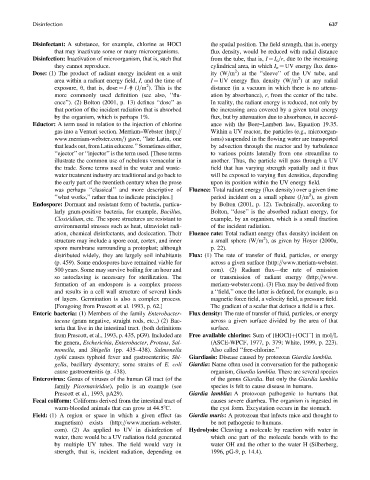Page 682 - Fundamentals of Water Treatment Unit Processes : Physical, Chemical, and Biological
P. 682
Disinfection 637
Disinfectant: A substance, for example, chlorine as HOCl the spatial position. The field strength, that is, energy
that may inactivate some or many microorganisms. flux density, would be reduced with radial distance
Disinfection: Inactivation of microorganism, that is, such that from the tube, that is, I ¼ I o =r, due to the increasing
they cannot reproduce. cylindrical area, in which I o ¼ UV energy flux dens-
2
Dose: (1) The product of radiant energy incident on a unit ity (W=m ) at the ‘‘sleeve’’ of the UV tube, and
2
area within a radiant energy field, I, and the time of I ¼ UV energy flux density (W=m ) at any radial
2
exposure, u, that is, dose ¼ I u (J=m ). This is the distance (in a vacuum in which there is no attenu-
more commonly used definition (see also, ‘‘flu- ation by absorbance), r, from the center of the tube.
ence’’). (2) Bolton (2001, p. 13) defines ‘‘dose’’ as In reality, the radiant energy is reduced, not only by
that portion of the incident radiation that is absorbed the increasing area covered by a given total energy
by the organism, which is perhaps 1%. flux, but by attenuation due to absorbance, in accord-
Eductor: A term used in relation to the injection of chlorine ance with the Beer–Lambert law, Equation 19.35.
gas into a Venturi section. Merriam–Webster (http:== Within a UV reactor, the particles (e.g., microorgan-
www.merriam-webster.com=) gave, ‘‘late Latin, one isms) suspended in the flowing water are transported
that leads out, from Latin educere.’’ Sometimes either, by advection through the reactor and by turbulence
‘‘ejector’’ or ‘‘injector’’ is the term used. [These terms to various points laterally from one streamline to
illustrate the common use of nebulous vernacular in another. Thus, the particle will pass through a UV
the trade. Some terms used in the water and waste- field that has varying strength spatially and it thus
water treatment industry are traditional and go back to will be exposed to varying flux densities, depending
the early part of the twentieth century when the prose upon its position within the UV energy field.
was perhaps ‘‘classical’’ and more descriptive of Fluence: Total radiant energy (flux density) over a given time
2
‘‘what works,’’ rather than to indicate principles.] period incident on a small sphere (J=m ), as given
Endospore: Dormant and resistant form of bacteria, particu- by Bolton (2001, p. 12). Technically, according to
larly gram-positive bacteria, for example, Bacillus, Bolton, ‘‘dose’’ is the absorbed radiant energy, for
Clostridium, etc. The spore structures are resistant to example, by an organism, which is a small fraction
environmental stresses such as heat, ultraviolet radi- of the incident radiation.
ation, chemical disinfectants, and desiccation. Their Fluence rate: Total radiant energy (flux density) incident on
2
structure may include a spore coat, cortex, and inner a small sphere (W=m ), as given by Hoyer (2000a,
spore membrane surrounding a protoplast; although p. 22).
distributed widely, they are largely soil inhabitants Flux: (1) The rate of transfer of fluid, particles, or energy
(p. 459). Some endospores have remained viable for across a given surface (http:==www.meriam-webster.
500 years. Some may survive boiling for an hour and com). (2) Radiant flux—the rate of emission
so autoclaving is necessary for sterilization. The or transmission of radiant energy (http:==www.
formation of an endospore is a complex process meriam-webster.com). (3) Flux may be derived from
and results in a cell wall structure of several kinds a ‘‘field,’’ once the latter is defined, for example, as a
of layers. Germination is also a complex process. magnetic force field, a velocity field, a pressure field.
[Foregoing from Prescott et al. 1993, p. 62.] The gradient of a scalar that defines a field is a flux.
Enteric bacteria: (1) Members of the family Enterobacter- Flux density: The rate of transfer of fluid, particles, or energy
iaceae (gram negative, straight rods, etc.,) (2) Bac- across a given surface divided by the area of that
teria that live in the intestinal tract. (both definitions surface.
from Prescott, et al., 1993, p. 435, pG9). Included are Free available chlorine: Sum of [HOCl]þ[OCl ] in mol=L
the genera, Escherichia, Enterobacter, Proteus, Sal- (ASCE-WPCF, 1977, p. 379; White, 1999, p. 223).
monella, and Shigella (pp. 435–438). Salmonella Also called ‘‘free-chlorine.’’
typhi causes typhoid fever and gastroenteritis; Shi- Giardiasis: Disease caused by protozoan Giardia lamblia.
gella, bacillary dysentery; some strains of E. coli Giardia: Name often used in conversation for the pathogenic
cause gastroenteritis (p. 438). organism, Giardia lamblia. There are several species
Enterovirus: Genus of viruses of the human GI tract (of the of the genus Giardia. But only the Giardia lamblia
family Picornaviridae), polio is an example (see species is felt to cause disease in humans.
Prescott et al., 1993, pA29). Giardia lamblia: A protozoan pathogenic to humans that
Fecal coliform: Coliforms derived from the intestinal tract of causes severe diarrhea. The organism is ingested in
warm-blooded animals that can grow at 44.58C. the cyst form. Excystation occurs in the stomach.
Field: (1) A region or space in which a given effect (as Giardia muris: A protozoan that infects mice and thought to
magnetism) exists (http:==www.meriam-webster. be not pathogenic to humans.
com). (2) As applied to UV in disinfection of Hydrolysis: Cleaving a molecule by reaction with water in
water, there would be a UV radiation field generated which one part of the molecule bonds with to the
by multiple UV tubes. The field would vary in water OH and the other to the water H (Silberberg,
strength, that is, incident radiation, depending on 1996, pG-9, p. 14.4).

